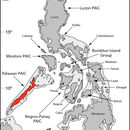en
names in breadcrumbs


Gekko athymus is one of ten currently recognized, endemic species of Gekko in the Philippines. This species has a strictly crepuscular (active during twilight) daily activity cycle (R. Brown, personal observation), which makes it behaviorally unique (remaining Philippine species are generally nocturnal but not strictly crepuscular). Additionally, Gekko athymus is large, and morphologically distinctive and unlike other taxa in the archipelago (Brown and Alcala, 1962, 1978; Brown et al., 2009). Gekko athymus is known only from the island of Palawan in the west-central Philippines.
Recent studies and increased survey efforts throughout the Philippines have resulted in a dramatic increase in the diversity of gekkonid lizards in the country. The archipelago is now known to support ten genera and at least 48 described species in the genera Cyrtodactylus (9 species), Gekko (12–13), Gehyra (1), Hemidactylus (5; including platyurus, a species formerly assigned to Cosymbotus), Hemiphyllodactylus (2), Lepidodactylus (6), Luperosaurus (8), Pseudogekko (4), and Ptychozoon (1) (Taylor, 1922a,b; Brown and Alcala, 1978; Brown and Diesmos, 2000; Brown et al., 1997, 1999, 2007, 2008, 2009, in press; Gaulke et al., 2007; Linkem et al., 2010; Welton et al., 2009, 2010a, b; Zug, 2010).
Ten species of Gekko are considered endemic to the archipelago (Brown et al., 2009; Linkem et al., 2010) and two additional species with broad geographic distributions (G. gecko, G. monarchus) are also known from the country (Taylor, 1922a, b; Brown and Alcala, 1978; Ota et al., 1989). The ten endemic Philippine species are G. athymus, G. carusadensis, G. crombota, G. ernstkelleri, G. gigante, G. mindorensis, G. palawanensis, G. porosus, G. romblon, and G. rossi. These species represent a considerable range in body size, general appearance, and ecological attributes, but all possess the following combination of morphological traits: (1) body size moderate, with relatively long, slender limbs; (2) near complete absence of interdigital webbing or cutaneous body expansions; (3) dorsal tubercles arranged in longitudinal rows on the dorsum (except for G. athymus, in which dorsal tuberculation is absent); (4) scales of dorsum between tubercle rows minute, non-imbricate; (5) scales of venter enlarged, imbricate, flat; (6) differentiated postmentals elongate; and (7) subcaudals enlarged, plate-like (Brown and Alcala, 1978; Brown et al., 2007, 2008, 2009).
Gekko athymus can be distinguished from congeners by the following combination of characters (1) large body size (SVL 99.2–119.9 mm for adult males; 88.2–117.1 for females); (2) vertebral coloration with light and dark inverted V-shapes; (3) supralabials 11–13; (4) preanofemorals 20–24; (5) Toe IV scansors 18–22; (6) internasals contacting rostral 1; (7) scales contacting nostril 5; (8) midbody ventral scales 30–36; (9) midbody dorsal scales 92–104; (10) paravertebral scales in axilla–groin distance 158–179; (13) ventral scales in axilla–groin distance 66–72.
Gekko athymus is known only from the island of Palawan in the west-central Philippines.
Gekko athymus is recognized to occur in the Palawan Pleistocene Aggregate Island Complex.
SVL 99.2–119.9 mm for adult males; 88.2–117.1 for females
Gekko athymus, also known as the Brown's gecko[2] or smooth-scaled narrow-disked gecko,[1] is a species of gecko.[1][2] The species is endemic to the island of Palawan in the Philippines.[1][2] It is a rare, crepuscular animal that has only been found in intact primary forest.[1]
Gekko athymus, also known as the Brown's gecko or smooth-scaled narrow-disked gecko, is a species of gecko. The species is endemic to the island of Palawan in the Philippines. It is a rare, crepuscular animal that has only been found in intact primary forest.